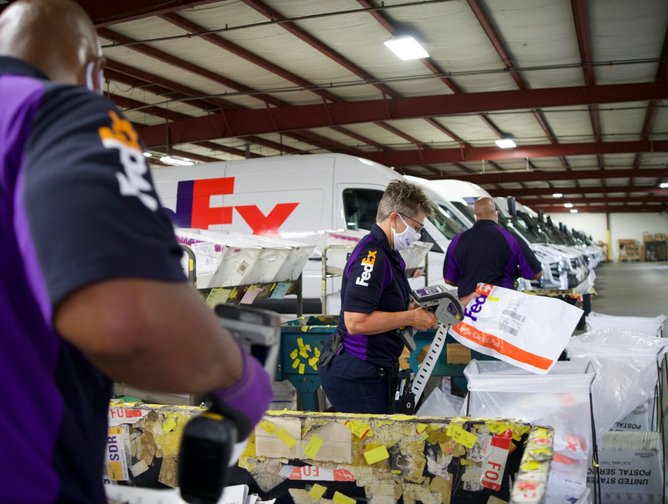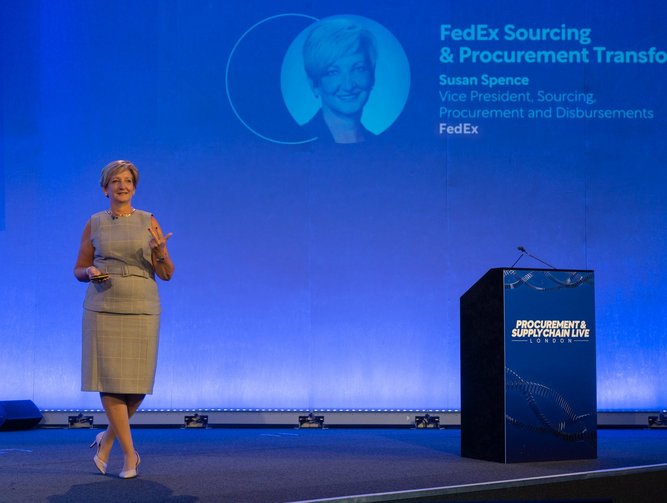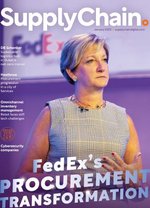Sue Spence – transforming sourcing and procurement at FedEx
Brutally honest. That’s a phrase that springs to mind when talking procurement transformation with Sue Spence – Vice President, Global Sourcing & Procurementat FedEx Corporation.
Drafted in by the shipping and transportation giant a little over nine years ago to build a centralised sourcing and procurement operation from scratch, straight-talking Spence wasted little time in making a big impression.
“One of my favourite phrases is ‘begin with the end in mind’,” she says. “My approach to designing the future state of sourcing and procurement at FedEx was to first define what world-class looked like for our function. We came up with seven characteristics of a best-in-class organisation and then gave ourselves a brutally honest assessment (red, yellow, green) on how close or far apart we were from those characteristics. There was a whole lot of red back in 2013, but by 2018, it was a whole lot of green.”
Let’s just put the scale of the task Spence faced into perspective. In fiscal year 2022, FedEx delivered 3.1 billion packages. That is almost 8.5 million packages per day, delivered globally, by plane, train and truck. Over 550,000 people work for FedEx, literally juggling billions of moving parts, schedules and itineraries.
A great deal of that US$17bn annual Spence spend goes on fuel, and when there is disruption in the supply chain, like during the Colonial Pipeline cyber attack, it would be easy for FedEx operartions to slowly run out of gas – were it not for robust risk assessment in the organisation’s supply chain. This is where Spence – and the sourcing and procurement team she has shaped – really shows her value.
Prior to joining FedEx, Spence had a 28-year career with United Technologies Corporation, in positions of increasing responsibility at the aerospace divisions of Pratt & Whitney, Hamilton Sundstrand and Sikorsky Aircraft as well as a key leadership role in Sourcing at the UTC Corporate office. She had multiple roles of traditional procurement, strategic sourcing as well as managing continuous improvement for both the assembly and maintenance and repair operations at Pratt & Whitney – experience that has proved invaluable in her FedEx role.
“My time managing continuous improvement taught me the criticality of the measurement system as well as ‘learning to see’ through process mapping, root cause and corrective action, and especially in business processes where there is so much opportunity to streamline,” she says.
Spence brought that methodology to FedEx, which proved an extra challenge as she was an ’outsider’, but also gave her the distance from the company to see a clearer route forward. But when you are tasked with building a world-class procurement team, what are you looking for? Spence is quick to list demonstrating category expertise, managing effective stakeholder relationships, making decisions based on data, not emotion, -monitored by a robust measurement system, focusing on process improvement to improve productivity, raising the bar on performance for both suppliers and employees and leveraging spend across the entire book of business you have with your suppliers. Recognising that this is a Herculean task for an organisation as complex and vast as FedEx, it’s also essential to proactively develop and manage the existing talent on your team. And that’s just for starters.
“In order to drive such a large transformation, you need to understand what you are getting into and do not underestimate the level of energy it will take,” says Spence. “This isn’t just referring to hours in the day, but mental energy to drive toward something new, especially in an organisation where outside executives are unusual.
“Be an evangelist about the mission and transparent with your team as much as possible; give frequent feedback and always explain what the accomplishment of the team’s goals can mean to their career. Be decisive, once you have allowed for multiple points of view to be heard. Don’t be afraid of the stretch goal and ensure when you ask for resources (both people and budget) you have a solid business case for your request.”
So just how did Spence achieve the sourcing and procurement transformation FedEx was hoping for? She says it was down to a number of what she calls guiding principles – five pillars that delivered the desired results. Lucky for us, she is happy to share:
- INCLUSION – include every one of our managers and their teams in creating the enabling initiatives that would help us accomplish the best-in-class characteristics, and allow those ‘future state teams’ to lead the execution of these projects.
- ALIGNMENT – socialise and gain alignment with our key stakeholders inside the company so they understand WHY we were undertaking the journey, HOW we would measure success, and WHAT service levels they could expect from us. In the first six months I was there, I met with 100 of the top executives of the company personally to explain the mission and gain their support for it.
- COMMUNICATION – frequent updates to my entire team about the progress of each of the initiatives and over communicate why they were important, how they contributed to the mission and how our value would connect and contribute to FedEx’s overall value for our stakeholders (employees, customers, and shareholders).
- ACCOUNTABILITY – commit to the team to train and coach them as much as possible so they could become world-class sourcing and procurement members but hold them to a very high level of accountability.
- TRANSPARENCY – create measurement systems for our team, both qualitative and quantitative; act with data and drive relentlessly to root cause and corrective actions for issues we uncover as we perform our work and deliver our value
As you can probably tell by now, as you would within five minutes of sitting face to face with Spence, her leadership style is inclusive, transparent, decisive and what she calls “biased for action”.
“My team will tell you I push like hell and am always digging for more info, more achievement, what’s next,” she says. “I love the debate and will switch sides of the debate to hear how they will defend their positions; I want them to be confident and anticipate as many questions as possible. I’ve often said if you can get by me, you are ready for anyone!”
In 2020, Spence won the coveted Institute of Supply Management’s J. Shipman Gold Medal – recognition of her advancement of the procurement and supply chain management profession. She is suitably modest about her achievement, saying her grown daughters now believe “mom may have a good idea or two every now and again” while also saying it has helped boost her LinkedIn connections. But don’t be fooled for a second – Spence appreciates the gravitas of the award, and her position as a role model both within procurement and in general.
“I attribute that to a diversity of experience within procurement – from the beginner level all the way up to the Chief Procurement Officer role, both on the direct as well as indirect side in very different industries,” she says.
“In business generally, I attribute that to working for my first 29 years in a very male-oriented environment that was also engineering focused. I am an economics and political science major with an MBA, and learning the technical side of the business presented quite the challenge.
“A non-technical female in a male-oriented engineering-focused industry….success took grit, resilience and asking a whole lot of questions. Being curious was/is a critical skill that has helped propel my career.”
Speaking at Procurement & Supply Chain LIVE London in October, Spence had the audience riveted both in her keynote session and the closing panel discussion. Respected and revered by her peers and the next generation of procurement professionals alike, she is a warm, honest, and supremely talented leader that other leaders can learn from. Which is just one reason why we expect Spence to continue to drive the shape of procurement in the foreseeable future. So what does she think that looks like?
“The transactional, repeatable work that we did 30 years ago will and should be automated and as touchless as possible,” she says. “The focus of our talented teams has to be strategic, market-savvy, innovative, value driven so that we are seen less as the back office support group and more as the partners for the business.”
You can imagine procurement professionals around the world nodding in agreement to that.






